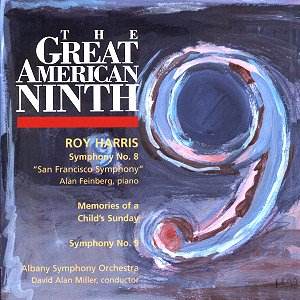Though Harris’ thirteen symphonies (i.e. if one excludes
the so-called Symphony – American Portrait of 1929, the
Symphony for Voices of 1935 and the Symphony for
Band "West Point" of 1952) form the core of his large
output, none really enjoyed the huge popularity of the masterly Third
Symphony (1938), acclaimed as America’s greatest symphony ever.
There are many reasons explaining this state of affairs: the Third is
a compact work wasting no time in developing its symphonic argument,
the thematic material is straightforward and memorable, and the scoring
is quite superb and highly personal. The later symphonies, with the
exception of the hybrid but highly enjoyable Fourth "Folksong
Symphony (1940, revised 1942), are more ambitious and developed
into more complex structures whereas the thematic material may be more
reticent and the scoring a bit heavy-footed and at times rather thick.
Nevertheless, much of the music in the late symphonies is far too good
to be recklessly ignored. As far as I am concerned, I believe that the
Fifth (1942, revised 1945) is the one that comes closest
to the Third, be it for the quality and memorability of the thematic
material and the mastery of the scoring. A new recording is long overdue
(the old Louisville recording re-issued on ALBANY TROY AR 012 has some
unexplained cuts) and should by now be a priority.
This being said, the Eighth and Ninth Symphonies, both
composed in quick succession in 1962, are among the finest. The Symphony
No.8 "San Francisco Symphony" was completed in early
1962 to celebrate the fiftieth anniversary of the San Francisco Symphony
Orchestra, but – more importantly – reworks some material of Harris’s
cantata Canticle of the Sun on St. Francis of Assisi’s
well-known text. Indeed the fourth part of the symphony is an orchestral
transcription of parts from the cantata. So, the subtitle refers to
the occasion for which the piece was written and to the evocation of
St. Francis’ life, though it has to be heard first and foremost as an
abstract piece of music. To a certain extent, it is fairly unique in
Harris’s symphonic output in that its scoring is much lighter, more
transparent than usual. It also includes an important part for amplified
piano composed for the composer’s wife Joanna. I had never heard the
Eighth Symphony and am now happy to confirm that it is a really fine
piece that deserves to be better known.
The Symphony No.9, written soon after
the Eighth, was commissioned by the Philadelphia Orchestra and first
performed by them in 1968 under Ormandy’s direction. Though it shares
some material with the Eighth, it is a more ambitious, weightier work.
Its three movements are quite contrasted and clearly characterised.
The opening "We, the people" is, according to Dan Stehman,
the most successful of Harris’ fast symphonic opening movements and,
quite unusually (i.e. by Harris’ standards), roughly in sonata form.
The sombre slow movement "...to form a more perfect Union"
is not without its more disturbing moments, especially near the climax.
The last movement "Contrapuntal Structures" , subtitled
"...to promote the general welfare", is one
of the biggest and most complex of all Harris’s symphonies (pace
Dan Stehman), and a real orchestral tour de force. It is a huge triple
fugue falling into three sections building towards an imposing coda.
Undoubtedly a powerful statement with more than a hint of "leave
it or take it", but nevertheless quite impressive.
This welcome release opens with a rarity, Memories
of a Child’s Sunday, composed in 1945 for Arthur Rodzinski,
then Music Director of the New York Philharmonic. This short work is
lighter in mood and scoring although the central movement Imagining
Things is somewhat more complex. It opens as a gentle nocturne,
but the dreamy mood is soon disrupted by a nightmarish central section
dispelled by a peaceful restatement of the opening theme. The outer
movements are also very fine: the first movement Bells has a
beautiful theme supported by a bell-like accompaniment whereas the concluding
Play, a reworking of some earlier piano music, provides for a
lively conclusion sometimes redolent of the first movement from Respighi’s
Pines of Rome or of Ballet for Children from Bliss’s
Things to Come.
So, excellent, well-recorded performances of two substantial
Harris symphonies plus a quite enjoyable novelty. Harris fans will need
no further recommendation, but those who wonder what Harris’s symphonies
after the Third are will find much food for thought in this welcome
release.
Hubert Culot


